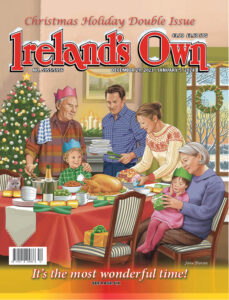By Paddy Ryan
As a nine-year-old sitting on the hard bench beside Donie, I didn’t envy his natural athletic prowess, his skill with a ball or his sweet rendition of popular songs learnt from older siblings. But I was green with envy at the stuff he regularly got in the American parcels.
There was the day he produced a shiny red and silver Roy Rodgers outfit that had a long holder for the silver gun. His copious school bag also contained the finishing touch of a black cowboy hat with golden tassels.
Over sixty years later, I can still see the lot laid out before me like sacred vestments.
Of course, the morality of cowboys and their treatment of unfortunate native Americans was something that would come much later. I don’t recall the exact details of the transaction and how I managed to obtain the Roy Rodgers outfit but I feel it could have been the shiny half-crown given to me by a generous uncle.
That was as close as I got to the American parcel but Donie had several aunts in Chicago — a city that sounded like Aladdin’s Cave to a nine-year old. While his American parcels must have contained clothes, they were of little interest except recalling the colourful ties that his father wore to Mass.
 Of much more immediate interest were the comics that Donie waved like golden nuggets in the school playground. I wonder if those aunts knew the joy they put into their boxes of stuff to cross the Atlantic?
Of much more immediate interest were the comics that Donie waved like golden nuggets in the school playground. I wonder if those aunts knew the joy they put into their boxes of stuff to cross the Atlantic?
Many years later, when I read the late John Healy’s terrific tale of ‘Nineteen Acres’, it was a revealing insight into the American parcel. Growing up near Charlestown, County Mayo, he recalled the family regularly receiving American parcels.
Years later while working as a journalist he visited his aunts in New York who had sent the parcels. To his amazement, he discovered that most of the stuff that reached his home had been bought in a local pawnshop and then sent to Mayo.
Perhaps it was karma that saw me, later, working in the Foreign Parcels Post in Dublin where I became intimately acquainted with the American parcels.
Indeed, a special section was devoted to them. All of them bore a Customs declaration, affixed by the sender, declaring their contents as ‘used clothing.’ Which indeed was nearly always true when the random checks were done and their contents laid out.
I recall that most of these that came through Dublin were for Mayo, Galway, Leitrim and Donegal. I’m sure many a child, like my friend Donie, was thrilled to receive the American goodies. Most of them also contained a few bars of chocolate or as Donie would have described it ‘candy’.
In another quirk of fate, the American parcel — the envy of my 1950s childhood—became a feature in my own household. My daughter was the regular recipient of stuff from her unmarried, maternal grandaunt, who lived in New York.
These contained the prettiest dresses, decorations to ‘dress’ the Christmas tree and on one occasion, when she was eleven or twelve a Swatch watch. I can still recall her delight as she proudly showed off the watch to her friends. I could empathise with their envy. And the bed of Heaven to that dear generous grandaunt who despatched such joy to a child.
While I believed the American parcel to be an Irish phenomenon, I was mistaken. About fifteen years ago at a conference in Oslo, I was seated next to a senior Norwegian official at dinner. Our conversation ranged from Norway during WWII to her aunts and uncles who had emigrated to Pittsburgh, Pennsylvania.
She went on to relate how as a child during and after WWII, she looked forward so much to the Pittsburgh parcels and the joy they gave her with American comics, candy and pretty clothes not available at home.
And I was reminded again of that red and silver Roy Rodgers outfit being carefully unwrapped from the great American parcel.


